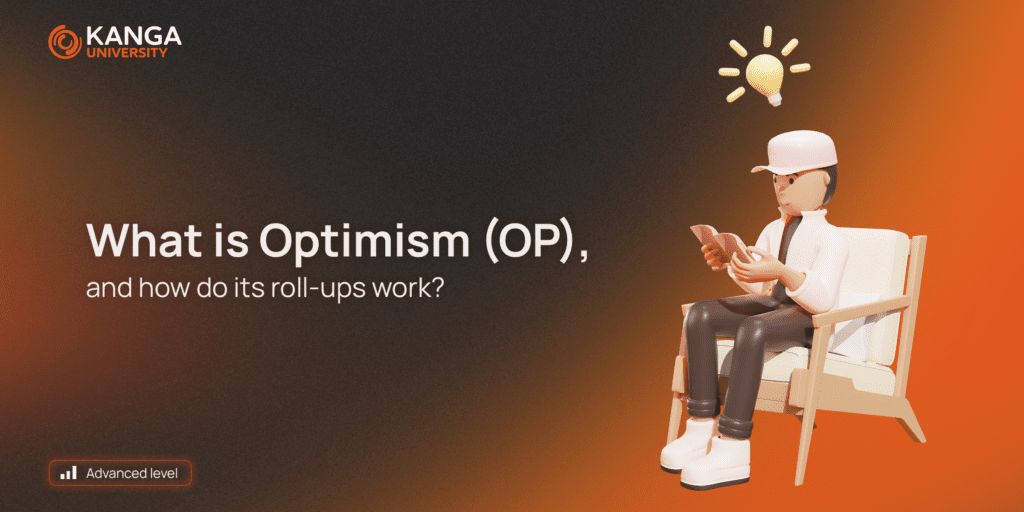
Optimism is a Layer 2 Ethereum solution. It was built to be cheap and easy to use. It first appeared in 2019, with the Mainnet launching in 2021. The network was designed to mirror Ethereum’s blockchain. Therefore, developers can implement existing smart contracts on the blockchain very efficiently.
Optimism is an Ethereum-based decentralized platform that allows us to trade and scale smart contracts instantly. OP is the platform’s own token.
How does Optimism work?
The network has its philosophy. It is based on four pillars: simplicity, pragmatism, sustainability and, of course, optimism. Optimism is a rollup that improves bandwidth and latency on the Ethereum main chain. How it works: calculations and data are moved off the main chain. This reduces congestion on the core network and improves Ethereum’s scalability.
Optimistic rollups have their own characteristic features. One of them is that little information about transactions is published on the chain, and it is automatically assumed that all transactions are valid.
What are roll-ups?
This is one of many scaling solutions. They help Ethereum to achieve a higher throughput of a given transaction. So, you make transactions outside Layer 1, then they are sent there and reach consensus. What is the advantage of this solution? The load on the main network is reduced, while at the same time, high security is guaranteed.
We have two main types of rollups:
- Zero-knowledge (ZK) Rollups – are responsible for calculations outside the chain and then send the proof of validity to the chain.
- Optimistic rollups – they assume a priori that transactions are valid by default and perform calculations in a fraud-proof way. However, only if there is a challenge.
Optimism belongs to the second category. It is also the mother chain of Ethereum.
How does the Optimism network work?
All blocks on Optimism are stored in a special smart contract. This is built on Ethereum and is called Canonical Transaction Chain-CTC. Such contracts contain a code that guarantees us that the current list of blocks cannot be changed by the latest Ethereum transactions. Of course, it can be broken, but only if Ethereum undergoes a restructuring and the order is changed.
Then we have block production, which is the responsibility of the sequencer. It helps the network and does the following things:
- It immediately confirms transactions and updates the network status.
- It constructs the second layer blocks and executes them.
- It forwards user transactions to the first layer.
- The sequencer immediately rejects or accepts transactions. And it does so exactly as they are received. When someone sends a payment, the sequencer checks whether it is valid and forwards it as a pending block. Such blocks are then grouped and forwarded to Ethereum for completion at regular intervals.
The main purpose of such block production is to reduce transaction fees. Of course, such a fee varies depending on the particular network load. Even if the transactions have been sent to the sequencer.
Block execution. Before we delve deeper into this topic, you need to know that Ethereum nodes fetch blocks from the Ethereum network. In contrast, Optimism nodes fetch blocks directly from the CTC Append-Only contract.
Optimism nodes consist of two basic components. They are the Ethereum Data Indexer and the Optimism Client Software. The Ethereum Data Indexer is designed to reconstruct the Optimism blockchain from blocks published in the CTC contract. It is also often referred to as Data Transport.
Fault Proofs. The use of Optimistic Rollups means that state commitments are published directly on the Ethereum network, without the need for a proof of the validity of those commitments. Proof is only required if a state commitment is challenged. If the challenge is successful, it is removed and replaced by another.
Token OP
This is the system’s own cryptocurrency. The entire network is managed by the so-called Optimism Collective. The administration of the Optimism Collective thus consists of two parts: Token House and Citizen House.
The Token House manages the Optimism network together with the OP token. The OP token itself has been distributed to hundreds of thousands of addresses that participate in the management of the system. The members of the Token House are responsible for the administration of the system and use OP tokens.
Interestingly, the OP token was introduced via airdrop. In the process, a total of 5% of the total supply of tokens was distributed. Who were the lucky ones to receive the token? They were DAO voters, Optimism users, Gitrcoin contributors and many others.
We recommend following the project – the team has confirmed that another airdrop is coming. It plans to set aside 19% of the total supply for this purpose. So maybe you’ll be the next lucky one!
Summary
Optimism is one of the equally popular Ethereum scaling solutions. The Optimism Foundation even wants to build the network’s Mainnet on top of Bedrock, a next-generation decentralized rollup architecture developed by Optimism Labs. We keep our fingers crossed and predict a bright future for this network!